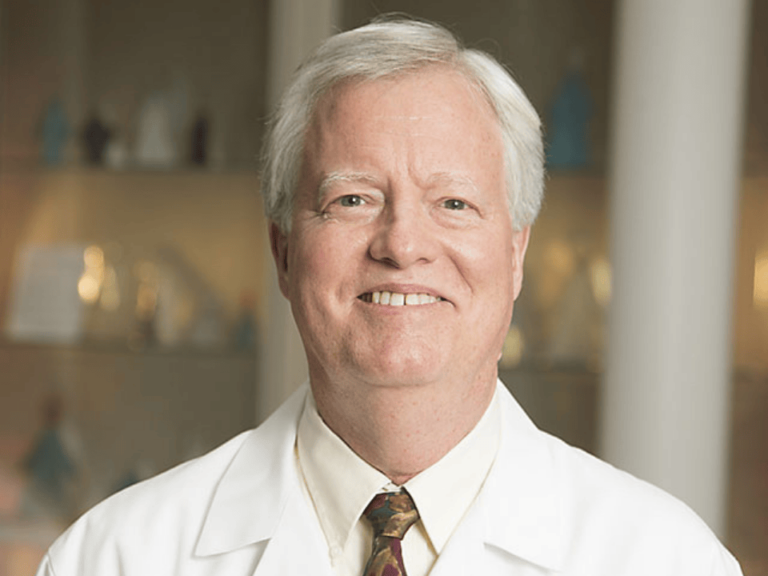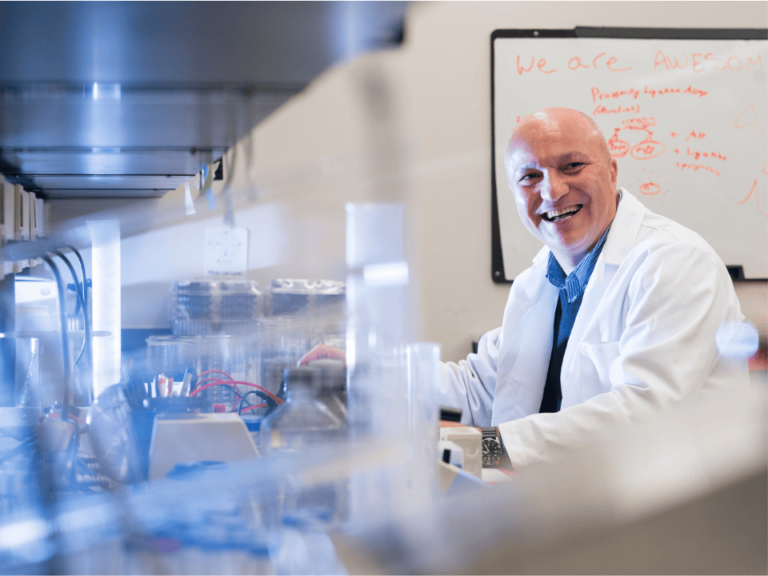MD Anderson and Texas Children’s Hospital have entered into a collaboration to build a $1 billion pediatric cancer hospital. The hospital, tentatively slated to open in 2031 or 2032, is on track to become one of the largest pediatric cancer hospitals in the world.
This podcast is available on Spotify and Apple Podcasts.
Peter WT Pisters, MD Anderson’s president, appears as a special guest in this week’s episode of The Cancer Letter Podcast. Together with Jacquelyn Cobb, associate editor of The Cancer Letter, and Paul Goldberg, editor and publisher, Pisters talked about the genesis of the collaboration.
“I went to several people on my team and I said to them, ‘Hey, I really would like to explore the possibility of a partnership with Texas Children’s Hospital.’ And they looked back at me and they said, ‘Peter, that is never going to happen. It’s an interesting idea, but it’s just impossible,’” Pisters said.
Pisters’s idea was met with a healthy dose of skepticism, but he was tenacious.
“I wanted to really look at all the possibilities to do something spectacular, and despite the fact that I was being told that I was wasting my time, I scheduled a lunch with Mark Wallace, who’s the CEO of Texas Children’s Hospital at that time, and Mark and I had lunch together at MD Anderson.
“And over lunch, I said, ‘Hey, Mark, you have an incredible program. We have a set of unbelievable capabilities. How about if we did this, we unified the program, we unified educational efforts, we unified research programs, and we built a facility?’
“Mark looked back at me and he said, ‘That is an amazing idea.’ By the end of the lunch, we shook hands and we said, ‘Let’s do it.’ And here we are.”
Pisters said that he has known that he wants to make an impact in pediatric oncology for much of his career—almost immediately upon accepting the role of president of MD Anderson.
“In August of 2017 when the Regents gave me the privilege of leading this organization, 30 minutes after I’d been notified, I thought to myself, “I really want to do something gigantic for pediatric cancer.” Pisters said. “And, eight years later, it’s now a reality, and this is just spectacular and phenomenal for children with cancer.”
Stories mentioned this week include:
- How MD Anderson and Texas Children’s made plans to build a $1 billion pediatric cancer hospital—one of the world’s largest
- At House hearing, Democrats clash with RFK Jr. over “radical obstruction of congressional oversight,” vaccine policies—Rep. Lori Trahan: “People are going to die”
- Building cancer care resilience through international observerships: Lessons from Ukraine
- As cancer patients use AI chatbots, dangers lurk—but new safeguards can help
- Jacqueline Corrigan-Curay to retire as acting head of CDER at FDA
- RFK Jr.’s new committee votes on vaccine recommendations, despite Sen. Cassidy’s call for meeting delay
This episode was transcribed using transcription services. It has been reviewed by our editorial staff, but the transcript may be imperfect.
The following is a transcript of this week’s In the Headlines, a weekly series on the Cancer Letter Podcast:
Jacquelyn Cobb: This week on The Cancer Letter Podcast…
Peter WT Pisters: I really want to do something gigantic for pediatric cancer. And eight years later, it’s now a reality and this is just spectacular and phenomenal for children with cancer.
Paul Goldberg: Well, this is gigantic. Can we just get a sense of how gigantic? Because it’s clearly Texas-sized, but it’s actually worldwide-sized. If you could walk us through that.
Jacquelyn Cobb: You are listening to the Cancer Letter Podcast. The Cancer Letter is a weekly independent magazine covering oncology since 1973.
Paul Goldberg: I’m your host, Paul Goldberg, editor and publisher of The Cancer Letter.
Jacquelyn Cobb: And I’m your host, Jacquelyn Cobb, associate editor of The Cancer Letter. We’ll be bringing you the latest stories, groundbreaking research, and critical conversations shaping oncology.
Paul Goldberg: So, let’s get going.
Jacquelyn Cobb: Hey Paul, how’s it going?
Paul Goldberg: Oh, great, great. Life is good. Enjoying my work and my job, because it’s a great time to be a journalist.
Jacquelyn Cobb: Yeah, you had a really awesome story this week. It was a joy to read. It was really, really lovely.
Paul Goldberg: Well, also, it’s hopeful, this is where childhood cancer shows the way for the adult for adult cancer, how to treat it, how to research it. It also shows how important research is.
Jacquelyn Cobb: Totally. Yeah. I mean, there’s a lot to unpack, as I’m sure we will get to as we get into the story. That’s the story we’re going to be diving into today. So first, just to stay on track to try to keep us linear as we’re so excellent at doing, Paul, I’ll take us through-
Paul Goldberg: That’s my strength, keeping things linear.
Jacquelyn Cobb: … Exactly. Just about as linear as a circle.
Paul Goldberg: Yes.
Jacquelyn Cobb: I will take us through last week’s headlines. As we’ve said, Paul wrote a really awesome cover story about a new collaboration between MD Anderson and Texas Children’s Hospital to build one of the largest pediatric cancer hospitals in the world. And, I think we can say confidently now in the U.S. as well. Well, the largest in the U.S. and one of the largest in the world to be clear. And they hope to have this open by 2031. So definitely, we’ll have more to talk about with that story later in the episode, so stay tuned. Claire wrote a story about HHS secretary Robert F. Kennedy Jr. appearing before the House Energy and Commerce Subcommittee to defend the HHS FY26 budget, or budget proposal, excuse me. At the hearing, democratic representatives clashed with Kennedy saying that the secretary’s actions have led to “radical obstruction of congressional oversight.” Rather than Kennedy’s promise of “radical transparency.”
We had two guest editorials last week. One was about the mentorship program between Ukrainian cancer docs and doctors in the U.S., and the other discussed the potential perils that patients may encounter as they increasingly turn to AI chatbots to answer clinical questions.
In our Cancer Policy section this week, we covered Jacqueline Corrigan-Curry’s retirement as acting head of CDER at FDA, along with the first meeting of HHS Secretary Kennedy’s newly appointed vaccine committee, despite Senator Bill Cassidy’s public call for the meeting to be delayed until “more experienced individuals make up the committee.”
Earlier this month, Kennedy had fired all 17 members of this committee and had repopulated the committee with eight new people, at least four of whom had been publicly critical of vaccines.
Yeah, so today we’re going to talk about, like we said, a much more hopeful story. And yeah, I think I’d love to start, Paul, with the question, how did this idea for the collaboration between MD Anderson and Texas Children’s Hospital come about?
Paul Goldberg: Well, Jacquelyn, that was an excellent question, but rather than listen to me drone on and attempt to answer it, we just happened to have Dr. Pisters right here, so why don’t you ask him?
Jacquelyn Cobb: Hello, Dr. Pisters, lovely to have you here.
Peter WT Pisters: Great to be with both of you.
Jacquelyn Cobb: So, my excellent question was, how did this idea for the collaboration between MD Anderson and Texas Children’s come about?
Peter WT Pisters: Well, this is something that had occurred to me at different stages in my career. In the days when I was a surgeon, part of the hallway where the scrub sinks are located has a view through a bank of windows, and through those windows you can see the magnificence of Texas Children’s Hospital. And commonly, I’d be sitting at the scrub sink scrubbing, and I would be with the person next to me. I would say, “I don’t understand why we don’t work with them.”
And then, later on, in August of 2017 when the Regents gave me the privilege of leading this organization, 30 minutes after I’d been notified, I thought to myself, “I really want to do something gigantic for pediatric cancer.” And, eight years later, it’s now a reality, and this is just spectacular and phenomenal for children with cancer.
Paul Goldberg: Well, this is gigantic. Can we just get a sense of how gigantic? Because it’s clearly Texas-sized, but it’s actually worldwide-sized. If you could walk us through that.
Peter WT Pisters: Well, when we take the complementary features, and the size, and scale of each of the two programs that we currently have, which are both nationally ranked, and we put them together, we believe that we will instantly have the largest program in pediatric oncology in the nation, and that will be backed by our clinical trials engine, our industry relationships, the amazing partnerships that we have, and the ability that we have to partner with Texas Children’s Hospital that has a health plan that has large volumes and has incredible scale.
So I am just super excited about this opportunity and what it means for children with cancer. We know that this is a moment in time when we can have exceptional outcomes and we can achieve those outcomes through an incredible partnership that brings the strength of both organizations together. I am really, really excited to see this become a reality.
Jacquelyn Cobb: Wonderful. Yeah, I mean, I love the story. And, I love the part where you were told it was impossible or not really likely. I’d love to hear how that happened and how that changed over time.
Peter WT Pisters: Well, as we had the ideas, I went to several people on my team and I said to them, “Hey, I really would like to explore the possibility of a partnership with Texas Children’s Hospital.” And they looked back at me and they said, “Peter, that is never going to happen. It’s an interesting idea, but it’s just impossible.” And, that included all of the executives that I trust implicitly, as well as some executives that we have who had worked at Texas Children’s Hospital, had insights into perhaps what their thinking would be.
I think from my standpoint, I wanted to really look at all the possibilities to do something spectacular, and despite the fact that I was being told that I was wasting my time, I scheduled a lunch with Mark Wallace, who’s the CEO of Texas Children’s Hospital at that time, and Mark and I had lunch together at MD Anderson. And over lunch, I said, “Hey, mark, you have an incredible program. We have a set of unbelievable capabilities. How about if we did this, we unified the program, we unified educational efforts, we unified research programs, and we built a facility?”
Mark looked back at me and he said, “That is an amazing idea.” By the end of the lunch, we shook hands and we said, “Let’s do it.” And here we are.
Paul Goldberg: It’s such an amazingly obvious idea with pediatric oncology. I mean, going back to 25 years ago when the four pediatric oncology groups became COG, and in the story we quote Doug Rieman, the first chairman of COG saying, “My God, this is a great idea. It should have been done a long time ago.” So in a way, how do you see pediatric oncology as part of the structures of all oncology now?
Peter WT Pisters: Well, when we look at the progress that’s been made in pediatric oncology, it’s really been through clinical trials and enrollment of children with cancer into those trials. COG has had a big role in an effort to galvanize children and pediatric hospitals around the country. Now, we see the opportunity, especially with genomic understanding of pediatric cancer and the genetic basis for formulation of a lot of these cancers to harness genomic medicine in ways that never could have been imagined, say, a quarter-century ago. I think this really creates tremendous opportunities for us to accelerate discovery, especially when we fuse the talent, the creativity of two gigantic research institutes, and we put the researchers together in common space that’s modern design, that has flexible benches, has open lighting, has cafes where there can be lattes and laptops. And I think that that’s going to be an incredible opportunity to accelerate discovery for children with cancer.
We also know that over the past, say, 15 to 20 years, we’ve been focusing more securely and intently on teenagers and young adults with cancer, understanding this group that we now call adolescent and young adult, AYA, how their needs are uniquely distinct, and how we can really formulate a distinct physical facility for them that will be part of this project. I’m very, very excited about the potential for that and the opportunity to attract talent to this partnership from around the world.
Paul Goldberg: You mentioned that you have… Well, you mentioned, it’s well known that you have a $10 billion master plan for expansion of MD Anderson. And, this was not a part of it, so you had to find the money.
Peter WT Pisters: That’s right. As we were thinking about the future of the institution, we know that we have many opportunities in Houston, in the Texas Medical Center where we have significant construction plans already in flight. We have a gigantic $777 million facility that’s located in southwest Houston in Sugarland, which will serve a growing community and communities as far as Victoria and Corpus Christi. We’re building a campus in Austin, Texas, which will extend our mission in very, very impactful ways. And we’re looking for other ways to give back to a dynamic state that’s growing unbelievably right now. As you point out, and as I mentioned before, Paul, this was really not on the $10 billion plan, and so as we think about that, we will really have to rely extensively on philanthropy. When we have a cornerstone gift of 150 million from Rich and Nancy Kinder, we know their commitment to make Houston a better place. They are really viewed as leaders in our philanthropic community, and I’m very optimistic that we will see other gifts of comparable size that will help to propel this project forward.
Paul Goldberg: So you’ll do it entirely through philanthropy?
Peter WT Pisters: I think so. We’re ready to commit off of a strong balance sheet. And, I think we want this to become a reality. I believe that we’ll be able to cut the ribbon on this and welcome patients into the new facility in 2031.
Paul Goldberg: Fantastic. One thing that we talked about as I was reporting the story was the architecture of the place and the art. How do you see that? I can see that AYA place would be just extraordinarily cool.
Peter WT Pisters: I agree. Paul, we’re going through a stage now where hospital construction and design are going through really a gigantic sea change, and this really involves the integration of robotics and automation in a variety of different ways. We had the privilege of visiting the Children’s Hospital of Atlanta last October. We saw the magnificence of that facility, nine elevators dedicated to robots in that facility, and when we see the commitment to automation as well as technology in the rooms, we see what the future of hospital design and construction will be.
Separate and apart from that, we have a really interesting program at MD Anderson to integrate art with architecture. We know that art really is something that patients are really attracted to. It gives them something that provides hope, that provides a focus, that takes them away from different components of their disease and the feelings around that. It’s also very inspiring for employees.
We’ve looked at different opportunities around the country to integrate art with architecture, and there are some phenomenal examples that we have looked at, like Cedars-Sinai, the Cleveland Clinic, Baptist MD Anderson Cancer Center in Jacksonville, and the Penn Pavilion, where you can see the impact of the integration of art with architecture. We’ve recruited an art director and we have an ambitious plan to integrate art with architecture and to really galvanize the philanthropic community in Houston, in Dallas, and Austin, and San Antonio to really help us bring out an environment hope, an environment that’s inspired by the art that is around the patients, the families, and the employees.
Paul Goldberg: Oh, I’d love to do a story about your art director. We will definitely come back and focus on that.
Jacquelyn Cobb: I think my last question is just circling back, you touched on it already, but I would love to hear more about just the fact that pediatric cancers are inherently like a rare disease, and Paul mentioned the formation or the consolidation of the different children’s research groups. And, yeah, I’m just wondering if that plays a role in how you’re thinking about putting this collaboration together.
Peter WT Pisters: It definitely does. When we look at clinical trials across the nation, COG has been such a strong engine for facilitating collaboration and accrual to these pivotal trials which move the needle dramatically, and you can just see the outcomes for pediatric patients are really dramatically changed as a consequence of clinical trials. As we all know, pediatric cancer is the poster child in many ways for what clinical trials can accomplish. When we think about the future, we know that many of the additional opportunities that we have will be informed by the genomic understanding of pediatric, and adolescent, and young adult cancer.
Cancer in the early stages of life is often genetically based. We know that because there isn’t a decades-long history of environmental exposure, microplastic exposure, or exposure, for example, to ultra-processed, or lack of exercise. And so, we can see more consistently the need to use genomic medicine to understand and unpack the mysteries of these cancers. Thankfully, we have sequencing technology. We have unbelievable use of AI in genomic medicine today. And I’m really excited about what this means for our ability to move the needle and advance discovery, innovation, and cures for patients with pediatric cancer, particularly when you see where we are now, the technology that’s evolved, and this relationship, which I think will supercharge our efforts to really advance pediatric oncology.
Paul Goldberg: That’s fantastic. Is there anything we forgot to ask?
Peter WT Pisters: I think we’ve had a pretty good conversation about this in the past, and hopefully this conversation has helped to advance a lot of the concepts that we have. I’d love to come back to The Cancer Letter at evolved stages of this when we’re in a position to really describe with greater precision the process of integration of two proud programs, the process of creating a unified effort around education, where we’ll have instantly the largest fellowship in pediatric oncology in the world, what that will mean for the next generation that will be educated and exposed to this environment. And then, the research synergies that will come when Baylor College of Medicine, MD Anderson, and Texas Children’s Hospital come together. It is really, really exciting to see this become a reality.
Paul Goldberg: Can’t wait. We’re certainly in, as far as coverage in the future. Thank you, Dr. Pisters.
Peter WT Pisters: Thank you so much, Paul. As I say often, this is a great time to be at MD Anderson.
Jacquelyn Cobb: Amazing.
Paul Goldberg: And it’s a great time to be a journalist. Thank you.
Jacquelyn Cobb: Thank you so much.
Thank you for joining us on The Cancer Letter Podcast, where we explore the stories shaping the future of oncology. For more in-depth reporting and analysis, visit us at cancerletter.com. With over 200 site license subscriptions you may already have access through your workplace. If you found this episode valuable, don’t forget to subscribe, rate, and share. Together, we’ll keep the conversation going.
Paul Goldberg: Until next time. Stay informed, stay engaged, and thank you for listening.











